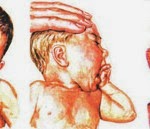Flatfoot (pes planus) is a condition in which the longitudinal arch in the foot, which runs lengthwise along the sole of the foot, has not developed normally and is lowered or flattened out. One foot or both feet may be affected.
What causes flatfoot?
Flatfoot may be an inherited condition or may be caused by an injury or condition such as rheumatoid arthritis, stroke, or diabetes.
Who is affected by flatfoot?
Children as well as adults may be flat-footed. Most children are flat-footed until they are between the ages of 3 and 5 when their longitudinal arch develops normally.
What are the symptoms?
People who have flat feet rarely have symptoms or problems. Some people may have pain because of:
- Changes in work environment.
- Minor injury.
- Sudden weight gain.
- Excessive standing, walking, jumping, or running.
- Poorly fitted footwear.
Children sometimes have foot discomfort and leg aches associated with flat-footedness.
How is it treated?
Treatment in adults generally consists of wearing spacious, comfortable shoes with good arch support. Your doctor may recommend padding for the heel (heel cup) or orthotic shoe devices, which are molded pieces of rubber, leather, metal, plastic, or other synthetic material that are inserted into a shoe. They balance the foot in a neutral position and cushion the foot from excessive pounding.
For children, treatment using corrective shoes or inserts is rarely needed, as the arch usually develops normally by age 5.
Surgery is rarely needed.
You may be able to relieve heel pain by stretching tight calf muscles. See a picture a calf stretch  exercise.
exercise.
- Stand about 1 ft (30 cm) from a wall and place the palms of both hands against the wall at chest level.
- Step back with one foot, keeping that leg straight at the knee, and both feet flat on the floor. Your feet should point directly at the wall or slightly in toward the center of your body. Keep the knee of the leg nearest the wall centered over theankle.
- Bend your other (front) leg at the knee, and press the wall with both hands until you feel a gentle stretch on your back leg (calf muscle).
- Hold for a count of 10 (increasing the count to 30 or longer as you continue over several weeks). Switch legs and repeat. Do this 2 to 4 times a day.
Foot-strengthening exercises done with a towel and weights. See a picture of atowel curl  exercise.
exercise.
- Place a towel on the floor, and sit down in a chair in front of it with both feet resting flat on the towel at one end.
- Grip the towel with the toes of one foot (keep your heel on the floor and use your other foot to anchor the towel). Curl your toes to pull the towel toward you.
- Repeat with the other foot. To increase strength, later use 3 lb (1.5 kg) to 5 lb (2.5 kg) weights (such as a large can of fruit or vegetables) on the other end of the towel.





.jpg)
.jpg)



.jpg)
.jpg)

.jpg)